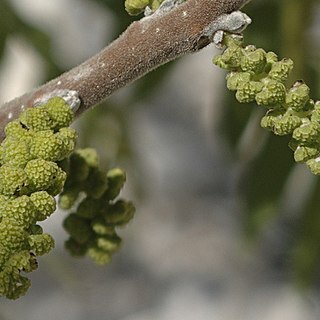A small bushy tree. It grows about 8 m high. The stem is 15-50 cm across. The leaves are compound and 20-33 cm long. The leaves have leaflets along the stalk. There are usually 7-13 leaflets. They are narrow and sword shaped. There are small teeth along the edge. The young leaves are grey to brown. They become green but turn yellow in autumn. The flowers are small and green. The male flowers have about 20 stamens and occur in catkins. The female flower has a 2 lobed style and occur as a few flowers at the tip of the same twig. The fruit are 12-19 mm across and have a thin hairy husk. The nut is hard and grooved with a thick shell. The seed is small and edible.


